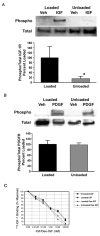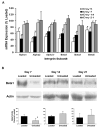Skeletal unloading-induced insulin-like growth factor 1 (IGF-1) nonresponsiveness is not shared by platelet-derived growth factor: the selective role of integrins in IGF-1 signaling
- PMID: 21932337
- PMCID: PMC3222734
- DOI: 10.1002/jbmr.511
Skeletal unloading-induced insulin-like growth factor 1 (IGF-1) nonresponsiveness is not shared by platelet-derived growth factor: the selective role of integrins in IGF-1 signaling
Abstract
Integrin receptors bind extracellular matrix proteins, and this link between the cell membrane and the surrounding matrix may translate skeletal loading to biologic activity in osteoprogenitor cells. The interaction between integrin and growth factor receptors allows for mechanically induced regulation of growth factor signaling. Skeletal unloading leads to decreased bone formation and osteoblast proliferation that can be explained in part by a failure of insulin-like growth factor 1 (IGF-1) to activate its signaling pathways in unloaded bone. The aim of this study is to determine whether unloading-induced resistance is specific for IGF-1 or common to other skeletal growth factors, and to examine the regulatory role of integrins in IGF-1 signaling. Bone marrow osteoprogenitor (BMOp) cells were isolated from control or hindlimb suspended rats. Unloaded BMOp cells treated with IGF-1 failed to respond with increased proliferation, receptor phosphorylation, or signaling activation in the setting of intact ligand binding, whereas the platelet-derived growth factor (PDGF) response was fully intact. Pretreatment of control BMOp cells with an integrin inhibitor, echistatin, failed to disrupt PDGF signaling but blocked IGF-1 signaling. Recovery of IGF-1 signaling in unloaded BMOp cells followed the recovery of marked reduction in integrin expression induced by skeletal unloading. Selective targeting of integrin subunits with siRNA oligonucleotides revealed that integrin β1 and β3 are required for normal IGF-1 receptor phosphorylation. We conclude that integrins, in particular integrin β3, are regulators of IGF-1, but not PDGF, signaling in osteoblasts, suggesting that PDGF could be considered for investigation in prevention and/or treatment of bone loss during immobilization and other forms of skeletal unloading.
Copyright © 2011 American Society for Bone and Mineral Research.
Conflict of interest statement
All authors state that they have no conflicts of interest.
Figures







References
-
- Bikle DD, Halloran BP. The response of bone to unloading. J Bone Miner Metab. 1999;17(4):233–44. - PubMed
-
- Globus RK, Bikle DD, Morey-Holton E. The temporal response of bone to unloading. Endocrinology. 1986;118(2):733–42. - PubMed
-
- Halloran BP, Bikle DD, Harris J, Foskett HC, Morey-Holton E. Skeletal unloading decreases production of 1,25-dihydroxyvitamin D. Am J Physiol. 1993;264(5 Pt 1):E712–6. - PubMed
-
- Halloran BP, Bikle DD, Harris J, Tanner S, Curren T, Morey-Holton E. Regional responsiveness of the tibia to intermittent administration of parathyroid hormone as affected by skeletal unloading. J Bone Miner Res. 1997;12(7):1068–74. - PubMed
-
- Sakata T, Halloran BP, Elalieh HZ, Munson SJ, Rudner L, Venton L, Ginzinger D, Rosen CJ, Bikle DD. Skeletal unloading induces resistance to insulin-like growth factor I on bone formation. Bone. 2003;32(6):669–80. - PubMed
Publication types
MeSH terms
Substances
Grants and funding
LinkOut - more resources
Full Text Sources
Other Literature Sources
Miscellaneous

